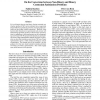Free Online Productivity Tools
i2Speak
i2Symbol
i2OCR
iTex2Img
iWeb2Print
iWeb2Shot
i2Type
iPdf2Split
iPdf2Merge
i2Bopomofo
i2Arabic
i2Style
i2Image
i2PDF
iLatex2Rtf
Sci2ools
AAAI
1998
1998
On the Conversion between Non-Binary and Binary Constraint Satisfaction Problems
It is well known that any non-binary discrete constraint satisfaction problem (CSP) can be translated into an equivalent binary CSP. Two translations are known: the dual graph translation and the hidden variable translation. However, there has been little theoretical or experimental work on how well backtracking algorithms perform on these binary representations in comparison to their performance on the corresponding non-binary CSP. We present both theoretical and empirical results to help understandthe tradeoffs involved. In particular, we show that translating a non-binary CSP into a binary representation can be a viable solution technique in certain circumstances. The ultimate aim of this research is to give guidance for when one should consider translating between non-binary and binary representations. Our results supply some initial answers to this question.
| Added | 01 Nov 2010 |
| Updated | 01 Nov 2010 |
| Type | Conference |
| Year | 1998 |
| Where | AAAI |
| Authors | Fahiem Bacchus, Peter van Beek |
Comments (0)

